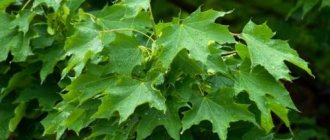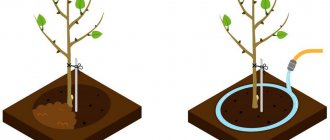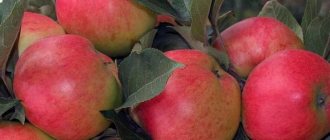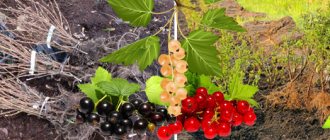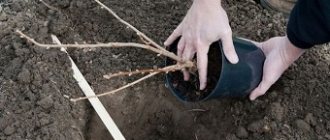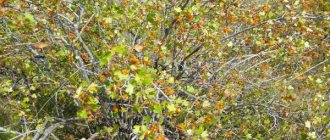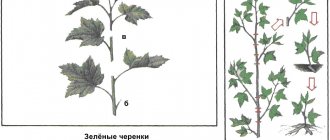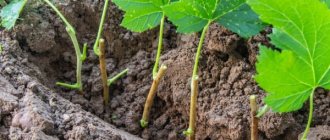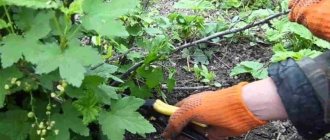Currant bushes can be found in almost all garden plots in central Russia; its tasty fruits contain a lot of vitamin C and useful biological active substances. Preparations made from black, red and white currants allow us to replenish the deficiency of vitamins in our body in winter and spring. This unpretentious plant does not require care, but in order to guarantee a large harvest of tasty and healthy berries, you need to choose the right place to place the bush and follow a few simple rules when planting it.
How to plant currants at home
If you decide to plant currant bushes on your site, you must first resolve several issues:
- Choose the appropriate variety.
- Choose a place to place the bushes.
- Study planting recommendations.
How to choose a good variety
It is advisable to choose varieties that are zoned in your area. They are most adapted to local climatic conditions.
Pay attention to the variety's resistance to diseases and pests. Currant bushes weakened by disease or pests are not capable of producing a good harvest and are unlikely to survive a harsh winter. Black varieties with large berries with a dessert taste have been bred; give preference to them for growing in your own garden. Technical varieties are more suitable for industrial breeding. The shape and size of the bush matter when planning its placement. Spreading bushes require more space; plants with a compact crown can be planted more often. If you place varieties with different ripening periods on your plot, you can extend the life of fresh berries.
It is recommended to plant bushes of different varieties nearby. Currants are self-fertile, but with cross-pollination the berries will be larger.
How to choose planting material
The choice of planting material will determine how successful the cultivation of currants in your garden will be. What to pay attention to:
- The age of the plant is one and two years.
- Appearance – well developed, without leaves, without damage or signs of disease.
- The root system is brown, completely lignified. The length of the roots is from 10 cm, there must be at least three main roots.
- The height of the stem is 30 cm, its thickness at the root collar is from 0.8 to 1 mm.
Rules for planting and preparing the pit
The planting pit must be prepared in advance. When planting in autumn, it is dug up 2-3 weeks before planting. If you plan to plant currants in the spring, prepare the hole in the fall. Recommended sizes:
- depth – 40 cm;
- diameter – 40 cm.
After the soil in the hole settles, it is filled ¾ with fertile soil. The seedling is placed in a hole at an angle of 45-60°, deepening the root collar by 10 cm. Deep planting at an angle stimulates the development of root buds.
The roots are straightened and the soil is carefully added so that no voids form between the roots. Then the soil is slightly compacted, a hole is made around the bush and half a bucket of water is poured into it. There is no need to mix ash with soil when filling planting holes; direct contact with the roots can cause burns. The ash should be scattered in a thin layer in the circle around the trunk and embedded in the grooves. Find out about using ash as fertilizer on your site at this link.
To retain moisture, it is advisable to mulch the soil. When planting in autumn, the seedling must be covered with soil 10 cm thick and mulched on top. These measures will help the young plant survive the winter. Alternatively, you can make a compost pit. To do this, in the spring or summer, a hole 60 cm deep and one and a half meters in diameter is dug at the site of future planting. During the summer, plant debris is placed in it, which is usually placed in a compost heap. The contents of the pit are moistened and layered with ash and soil.
When planting a seedling in a compost pit, good conditions are created for the development of its root system. Over the winter, the “compost” will settle. In the middle, dig a hole for planting a seedling and fill it with fertile soil. The top of the compost pit is filled with soil 20 cm thick. The seedling is planted in the hole at an angle, deepened by 10 cm. There is no need to add fertilizer to the planting pit. They are scattered in a circle near the trunk and sprinkled with earth.
Growing conditions
In order for currant bushes to develop normally, they need to be looked after:
- Currant is a moisture-loving plant; if the summer is hot and dry, the plant needs to be watered.
- This plant is shade-tolerant, but the berries will be tastier and larger if the bush is well lit. Regular pruning is required.
- It is necessary to protect bushes from diseases and pests by carrying out preventive and therapeutic measures.
- Timely feeding will help the plant bear fruit.
- Weeds need to be controlled.
- It is necessary to prepare the plant for wintering.
How to plant and care for currants in open ground
When growing currants in open ground, they resort to the usual agrotechnical methods:
- loosening the soil around the bushes every 2 weeks;
- weed removal;
- mulching;
- watering in the absence of precipitation at the beginning of the growing season and when ovaries appear (1 - 2 buckets per bush);
- pre-winter watering at the end of September (5 buckets per bush);
- seasonal feeding;
- preventive measures against diseases and pests;
- therapeutic measures when signs of disease and damage by harmful insects appear.
On the trellis
When growing currants on trellises, the berries grow larger due to better lighting. Well-ventilated bushes suffer less from diseases and pest invasions. Currants on a trellis especially need the following agrotechnical techniques:
- watering;
- mulching;
- pruning
The soil, not protected by branches, quickly heats up and dries out, so you need to water in the evening. In the absence of rain, two buckets of water should be poured under the bush. Watering is stopped when the berries are full.
Excessive watering during berry ripening leads to cracking of the fruit.
Mulching the soil in the tree trunk circle in the spring will save the soil from overheating. For these purposes, chopped straw, peat, and black non-woven material are used. Two-year-old seedlings with 3–5 branches are planted. After planting, the shoots are cut off, leaving 2–3 buds on them. The next year, of the grown shoots, those that are located in the plane of the trellis are left (no more than four). They are fanned out and tied to the bottom wire. In the next two to three years, these skeletal branches are not shortened.
In the second year, two basal shoots are left and secured with a fan. The rest are cut out. Subsequently, pruning is carried out to enhance branching. Once the branches reach the top wire, they are cut off. Before winter, it is necessary to remove the branches from the support so that they are covered with snow. Otherwise, the bush may become severely frozen and even die.
On the standard
If we grow currants on a trunk, we will get a small tree with a compact crown. Large clusters of berries are formed on it. It will take at least three years to form a standard.
Positive sides:
- good illumination of the crown;
- more sugar accumulates in fruits;
- it is easier to care for the tree trunk circle.
Flaws:
- less winter-hardy;
- the stem can be broken by strong winds.
Features of cultivation:
- Planting the seedling strictly vertically.
- When planting, a support must be installed to which the plant is securely fixed.
- Only one most developed shoot is left, the rest are removed.
- The top of the shoot is pinched, 3 or 4 buds are left in the upper part, the rest are removed.
- Side shoots are pinched above the fifth leaf.
- In the second year, this operation is carried out on growing shoots to form a crown.
- In subsequent years, sanitary pruning is done.
Growing on a trunk.
It is necessary to periodically remove all emerging growth from the trunk. Watering, fertilizing and pest and disease control are carried out as usual. For the winter, it is recommended to wrap the tree with agrospan in 2 - 3 layers. To protect the branches from breaking off, they are tied to the top of the support post. Each branch is “hung” on a rope secured to the top of the support with a self-tapping screw.
In the greenhouse
Currants are usually cultivated in open ground, but when growing bushes in a greenhouse, an earlier and more stable harvest can be achieved. The greenhouse method is recommended for industrial propagation.
Seedlings can be planted in a greenhouse in early April and harvested until the end of November. Modern greenhouses are equipped with equipment that allows you to regulate the conditions necessary for good development of currants:
- illumination;
- humidity;
- temperature.
In autumn, you should remove fallen leaves and trim bushes. In the spring, you will need to organize watering of the plants in the greenhouse. In Holland, red currant varieties (Dutch red, Rowada, Rolan) are grown in heated greenhouses. The yield from greenhouse plants is twice as high as that collected from bushes in open ground.
When does it begin to bear fruit after planting?
Currants will produce their first harvest 2–3 years after planting. Over the next five years, yields will increase, then drop sharply. Old bushes need to be rejuvenated or replaced with young plants.
The productive period of blackcurrant lasts up to 10 years. Red and white currant bushes can produce a good harvest up to 15 years of age.
Is it possible to plant different varieties of currants side by side?
Planting different varieties nearby will lead to an increase in yield, since cross-pollination causes an increase in the number of ovaries and the berries become larger.
Varieties must belong to the same species. Various varieties of red and white currants get along well side by side, and their proximity is favorable. But it is better to combine black berry varieties exclusively with each other.
Reference! Any variety is planted in an area protected from the wind.
They also pay attention to the short stature of certain varieties. Do not plant light-loving low-growing varieties under tall ones - this will lead to disease and death of the bushes.
Selecting a location
The future harvest largely depends on the correct choice of place for planting currants. It is necessary to take into account the composition of the soil and the proximity of groundwater. The development of the plant is greatly influenced by light and the presence of drafts.
The soil
Currants are not demanding on soil, but develop better on fertile loamy and sandy loam soils with a depth of at least 20 cm. Black currants can grow on heavy loams, while red currants prefer sandy loams with a lot of humus. If the soil is acidic (pH<5.5), it must be limed before planting.
Black currants grow well in fertile, moist soils. White and red currants prefer drier places.
Illumination
In a shaded place the bush grows strongly. Large leaves grow on its shoots, but fruiting will be weak. Red currants and their white-fruited varieties are more sensitive to light.
Groundwater
Currants cannot be planted on swampy soils. The groundwater level must be at least 1 meter from the ground surface. If the groundwater is high, the bush should be planted on an embankment. To plant several bushes, ridges with a height of 60 cm are constructed.
Drafts
Currants do not like drafts. It is better to plant bushes against the wall of a house or along a fence.
Is it possible to plant a new bush in place of the old one?
You cannot plant a bush in a place where currants have already grown before. The roots of the new plant should not get into the location of the old roots. It is advisable to step back 60–100 cm to the side.
Bad neighbors for red currants
Red currants have competitors in the plant world. To prevent low yields and possible death of the shrub, it is recommended to plant it at a distance of 5 m from these plants:
- Plum. This plant is not a competitor in the fight for nutrients, but it has a shady crown. Without sunlight, the berry bush stops bearing fruit and grows poorly.
- Cherries. It has an overgrown rhizome, which deprives the bushes of nutrients. This leads not only to low fruiting, but also to possible death.
- Raspberries. It has a large root system penetrating deep into the soil. It not only deprives the bush of nutrition and moisture, but also interferes with its development, reducing living space due to the growth of young shoots.
- Cherry. The crop shades the bush; its root shoots deprive the currant of nutrients. In addition, plants require different soil compositions.
For black
Garden plants not only struggle for space, light, water and nutrients, but also have common pests.
Unfavorable neighborhood:
- Red and white currants. Different needs for sunlight and moisture lead to the fact that the yield of shrubs drops to almost zero.
- Gooseberry. White gooseberries are susceptible to the same diseases as black berries. The pests of these plants are also the same. Planting them together will lead to massive development of diseases and uncontrolled proliferation of pests.
- Raspberries. It grows, does not allow other plants to develop, and absorbs all the moisture.
Layout of bushes on the site and the distance between them
Currant bushes are usually arranged in a row. You can use currants as a tapeworm; decorative varieties are suitable for this. When growing a bush on trellises, it is possible to create a “living wall” of plants.
The choice of distance between bushes is determined by the currant variety. For bushes with a spreading crown (Sakharnaya, Vologda), it is necessary to leave more space; compact bushes (Beloved, White Fairy) can be planted more densely.
Single bushes
When planted alone for decorative purposes, the bush is positioned in such a way that it looks beautiful against the background of a house wall or a group of plants. As the bush grows, it forms a shape using pruning. When purchasing a seedling of a new variety for you, plant it separately to evaluate its advantages and disadvantages. Regular currants with edible fruits, planted as a tapeworm, can also decorate the garden. Its beautifully cut foliage, showy flower clusters and colorful fruits will delight the eye throughout the season. The tapeworm bush looks beautiful on a well-kept lawn.
Rows
Traditionally, currants are planted in rows in the garden. Recommendations:
- The distance between rows should be at least one and a half meters.
- Bushes in a row are planted every 1.25 - 1.5 meters.
In tight rows
Bushes are planted closely in rows to save space in the garden. Recommendations:
- The rows are formed at a distance of one and a half meters from each other.
- Leave 80 cm between seedlings.
- Branches that interfere with neighbors must be cut out.
With dense planting, the yield from one bush decreases, but the total number of berries obtained from 1 square meter. meters, may increase.
On the trellis
The results obtained from experimental planting of currants on trellises pleased the researchers:
- Highly raised branches create better conditions for pollination, so more berries are produced.
- It is more convenient to cultivate the soil under planting.
- Makes harvesting easier.
Recommendations for planting:
- Bushes in a row should be planted at a distance of 0.75 meters. When plants are planted more densely, the trellises quickly thicken.
- Trellis are placed along the house, fence and garden paths. They form a hedge.
- To create a trellis, install pillars at a distance of at least 6 - 8 meters. Galvanized wire is pulled over them at levels of 50 cm, 100 cm and 150 cm.
- The branches are fixed to the trellis using twine or special plastic devices.
Medium-sized and tall bushes, medium-spreading, are suitable for growing in this way. Usually red currants are placed on trellises. To create a trellis, you can use an insulated lighting wire with a cross section of 2.5 mm.
Planting scheme
The ideal placement of currant bushes depends on the following important indicators:
- varieties;
- illumination of the area;
- soil for planting.
There are recommendations that need to be taken into account when planting berries.:
| Planting scheme | Note | |
| White | 2 m – between rows x 1.25 m between bushes | When different varieties of bushes are placed in the same area, cross-pollination occurs. Thanks to this, the yield and quality of berries increases. |
| Red | 2 – between rows x 1.5 m between bushes | |
| Black | 2.5 – between rows x 1.5 m between bushes | It is recommended to plant the variety separately from other types of shrubs to avoid loss of yield. |
Blackcurrant planting scheme
Red currant planting scheme
White currant planting scheme
Timing for planting seedlings
It is better to plant seedlings when they are dormant. Currants awaken very early, so it is recommended to plant them in the fall. In areas with harsh climates, it is better to plant in the spring.
It is better to plant bushes at sunset.
in autumn
After harvesting, the bushes can be divided and transplanted to a new location. The planting deadline is 20–30 days before frost. The seedlings must have time to take root.
In the middle zone, the best planting time is September and the first half of October. In warm regions, this work can be done until November. When planting in autumn, it is not recommended to prune branches.
in spring
Currants wake up very early, so they should be planted in the garden as soon as the soil thaws. Recommended time for the Middle Band:
- from mid-April to early May.
If planting is delayed, the plant will take a long time to take root. Only next spring will it begin to develop in full force. When planting in spring, it is recommended to shorten all shoots to 3–4 buds.
Moon calendar
The phases of the moon affect the survival rate and development of seedlings of berry bushes. It is recommended to plant during the waning moon. At this time, all the plant juices rush down and the root system develops well.
If you don’t have a Lunar calendar at hand, by looking at the sky in the evening, you can visually assess what phase our satellite is in. If the “month” resembles the letter “C” in shape, you can plant it (relevant if you live in the Northern Hemisphere).
Is it possible to plant currants in summer?
Seedlings with a closed root system can be planted even in summer. They have well-developed roots, so there is no need to trim the shoots after planting.
Growing currants without trellises
Currants are planted with the onset of autumn. If the weather is warm, planting dates are extended until mid-October. During early frosts, the bushes are dug in and planting is carried out in the first month of spring. In illuminated areas of land, seedlings with developed roots take root well.
Dig holes separately 35-45 cm deep or prepare a continuous trench. It is recommended to wait until the soil settles and begin planting shrubs a week after the depressions are formed. Compost or rotted manure is placed at the bottom of each hole. For soil with a high level of acidity, an oxidizing agent in the form of chalk or eggshells crushed in a coffee grinder is used.
Ash has to be poured into the ground every year, since the calcium it contains is poorly retained and is washed away by groundwater.
The soil is watered, the seedlings are placed in holes at an angle of 45° so that additional roots and new shoots are better formed (if you plant the plants without tilting, they will be single-stemmed). The straightened roots are buried in the ground 5–7 cm above the root collar and gradually covered. If you follow this pattern, strong bushes will grow.
It is more convenient to plant plants together, when one person holds the seedling and the second buries it. Plants are watered immediately using up to 4 buckets of water. The earth is carefully compacted in the direction of the trunk. Then the bushes are cut by half, or by a third if the root system is strong.
Thanks to pruning, the balance of the root system is restored; good growth is observed in the first year.
Neighborhood of currants in the garden
All plants somehow influence their neighbors, releasing their waste products into the soil and atmosphere. They occupy soil horizons with their roots, competing with their neighbors. How well currant bushes can get along with other inhabitants of your site depends on several factors:
- If the roots are at the same level, the plants will struggle to survive.
- Some plants release biologically active substances into the soil that inhibit the growth of other plants.
- Large trees shade the surrounding area.
- Plants can take up the same nutrients and trace elements from the soil.
- The same pests and diseases in plants will increase the likelihood of their damage.
All parts of black currant, including roots, secrete active phytoncides. They have a strong aroma.
What can be planted nearby?
It is best to group plantings by planting currant bushes of the same type nearby - black or red. Neighborhood allowed:
- Honeysuckle.
- Elderberry – drives away the moth.
Tansy, sorrel, onions and garlic, planted next to the currant bush, protect it from pests. Nasturtium growing in the tree trunk will repel pests in the summer, and after the plant dies, its rotted roots will attract earthworms.
Invalid neighborhood
Black and red currants should not be planted side by side. Close relatives will compete with each other, and their struggle will negatively affect the harvest; the berries will be small. As a result, the bushes may die. Read about the features of growing black currant of the Gross variety here.
It is not recommended to plant currants next to other plants:
- Gooseberries, they have the same pests.
- Raspberry, with its roots it tries to capture all the nearby space.
- Fruit trees, they will suppress the development of berry bushes. The distance to apple, cherry, pear, plum and sweet cherry trees should be at least 2.5 meters.
- Coniferous trees are carriers of columnar rust, a fungal disease.
Birch trees oppress all plantings located closer than 8 meters from it.
Good neighbors for red currants
The root system of the shrub is located at an average depth, so it has few competitors in extracting moisture and nutrients from the soil. Plants with shallow root systems will do well with this berry. The bush does not provide much shade, so low-growing garden crops can be planted under it.
Good neighbors will be:
- Onion. Does not consume excess moisture and needs light for quality development. Grows well between red currant bushes. The pungent smell of onions repels most pests, in particular bud mites.
- Gooseberry. The optimal neighbor for red berries. Both crops flower at the same time, and their cross-pollination significantly increases yield. The root system of these berry bushes is located directly under them, without unraveling to the sides. This allows them to obtain moisture and nutrients from the soil without limiting each other.
For black
The following are suitable neighbors for black currants:
- Honeysuckle. Shrubs develop well and bear fruit when nearby. Their chemical composition is similar, so the proximity will be favorable.
- Yoshta . Being a hybrid of gooseberries and currants, it coexists in the same area with these crops.
- Strawberry. The sharp aroma of currants repels many pests from strawberries, and frequent watering has a beneficial effect on the size and sweetness of the berries.
- Garlic. The bud mite, a dangerous pest of currants, is afraid of the spicy smell of garlic. This proximity has a positive effect on berry bushes.
How to seat
Currant bushes are easy to propagate. For this purpose, dividing the bush, rooting branches and cuttings are used.
How to plant cuttings
By regularly pruning currants, we get a lot of propagation material for free. Cuttings, segments of shoots, can be harvested in spring and autumn at home.
Scheme of planting cuttings.
Lignified
Lignified annual shoots with a diameter of 0.6 - 0.9 cm are suitable for cutting cuttings. The length of the cutting should be about 25 centimeters. The lower part is cut with an oblique cut under the lower bud, the apical “green” part is removed with a horizontal cut. Find out about the disadvantages and advantages of Gulliver blackcurrant here.
The cuttings must have at least 4 buds. Two go underground, two remain on the surface. The cuttings are planted in a specially designated place with loose fertile soil (“nursery”). They are planted in increments of 10–15 cm to a depth of 20 cm so that 2–3 buds remain above the surface. Plantings can be covered with a dark film, after cutting holes in it.
The dark film will protect the soil from drying out and will not allow weeds to emerge.
By autumn, the cuttings will form fully mature plants, ready for planting in a permanent place. Transplantation can be postponed until spring.
In order to speed up rooting, the cuttings are placed in a dark bottle of water. When well-developed roots appear, the cuttings are planted in the garden to grow.
Green
Green cuttings are cut from twigs that have not yet become lignified. The shoots must be flexible and not break when bent, and be at least 15 centimeters long. The upper part is cut 2 centimeters above the bud. Cuttings are harvested in cloudy weather.
For a day, the cuttings should be placed in a root formation stimulator (Heteroauxin), and then planted for rooting in a soil mixture consisting of peat, sand and compost in equal proportions. The cutting is buried 4 cm and covered with a plastic bottle on top. It is necessary to maintain high humidity in the greenhouse by spraying the cuttings several times a day for three weeks. They hide it from the sun.
After a month, the rooted cuttings are planted for growing in a “nursery”, and in the fall or next spring they are transplanted to a permanent place. Before planting, it is recommended to dip the lower end of the green cutting in a weak solution of potassium permanganate or treat it with a fungicide to protect it from rotting.
By layering
This is the simplest and most effective way to propagate currants; the survival rate is 100%. Two- or three-year-old shoots are dug in in the spring; by autumn they will already have formed their own root system.
How to do it:
- Near the bush you need to dig a groove 5 cm deep and fill it with a nutritious soil mixture.
- The branch is placed in this groove, pinned on top and covered with soil.
In the fall, a rooted currant branch should be carefully separated from the bush, and in the spring it should be transplanted to a new place.
To root several currant branches, the grooves are arranged in the form of rays extending from the center of the bush.
By division from an old bush
Old bushes of good varieties are propagated by division. They must be carefully dug up, divided into several parts and planted in a new place. This operation can be performed in autumn and spring. Find out when red currants ripen in this article.
It is convenient to divide the bush using a saw or pruning shears. The plant is dug out of the ground and the locations of the cuts are marked; the bush can be divided into 2, 3 and 4 parts. First, remove old dried roots and shorten healthy roots to 30 cm. After planting, new bushes need to be watered abundantly. The harvest can be harvested a year after division.
When dividing a bush, you need to mark its southern or northern side. When planting a “delenka” in a new place, it is advisable not to change the location of its shoots relative to the cardinal points, then the bush will take root faster.
Seeds
The method of growing currants from seeds is quite labor-intensive; breeders usually resort to it when developing new varieties.
Seedlings rarely inherit the qualities of their parent. The taste and size of the berries usually differ for the worse.
Growing scheme:
- Select large berries, rinse with running water and soak for a short time.
- Remove the seeds, dry them and put them away until spring.
- In March, soak the seeds for 20 minutes in a weak solution of potassium permanganate.
- Sow in a box with fertile soil, cover with film and place in a dark place.
- When the first shoots appear, move the box to a bright place.
- Divide the plants into separate pots when they grow to 15 centimeters.
- As soon as the threat of frost has passed, the young plants can be planted in the garden.
Distance between currant bushes when planting
When planting currants, a certain distance is maintained between the bushes, and other nuances that determine plant growth and the quality of the crop are taken into account.
Proper care and optimal environmental conditions are of considerable importance. The most suitable climate for the culture is a temperate climate.
Advice from experienced gardeners will help you grow bushes that are resistant to negative impacts and get a generous harvest.
Distance between currant bushes
Planting black or red currants is a rather complex process that requires not only a lot of labor, but also compliance with the correct technology. One of the most important points is the distance between currant bushes when planting them. This article will discuss this circumstance in more detail.
Conditions for growing currants
When choosing a place to plant currants, you need to take into account the characteristics of this plant. One of them is that it loves sunlight very much. Of course, this plant is quite unpretentious and is quite capable of surviving if the area is in the shade. However, the yield will be much lower than usual.
There are other conditions that affect the yield of berry bushes. Swampy soils are contraindicated for it. It is also undesirable if the site is in a lowland and waterlogging occurs after rain. It is unacceptable when the groundwater is too high. In the case when the depth to them is less than one meter, it is not recommended to plant currants.
This does not contradict the fact that the plant needs abundant watering. However, if the soil is swampy, this can lead to rotting of the roots. To prevent this from happening, it is advisable to drain the soil. For this purpose, you can arrange grooves around the plants to drain water, and also make a layer of sand in the soil.
Important! You should not plant bushes next to apple trees or other fruit trees. They will suppress each other's development. Also, when planting and growing, you need to avoid cold northern winds.
This can be done by choosing the right location or by planting plants that will provide protection from the wind. For this purpose, for example, you can use corn plantings
Also, when planting and growing, you need to avoid cold northern winds. This can be done by choosing the right location or by planting plants that will provide protection from the wind. For this purpose, for example, you can use corn plantings.
Not only the type of soil is of great importance, but also the condition of the seedlings. It is considered normal when there are from three to five skeletal roots (their length should be from 15 to 20 centimeters), the aerial part includes one or two sprouts.
Features of planting on an industrial scale
The consumption of healthy currant berries is increasing, so it is quite possible to organize your own business growing this berry bush. Berries and currant leaves can be processed. Selling seedlings is also a good source of income. This material will tell you about the best varieties of currants for Siberia.
If used correctly, a currant plantation can produce 10 tons of berries per hectare.
For industrial use, currants are grown in a compacted-thickened way:
- between plants leave from 25 to 50 cm;
- the distance between rows is 3.5 meters for machine processing and 2.8 meters for manual processing.
For planting, technical varieties suitable for processing are mainly used.
Varieties must meet the following requirements:
- Complex resistance to pests, diseases and climatic conditions.
- Simultaneous ripening of berries.
- Easy separation of the stalk.
To prolong the berry harvest, it is recommended to grow varieties of different ripening periods:
- early - 10% of plantings;
- average – 60%;
- late – 30%.
The bushes are planted, grouped by variety. For better pollination, it is recommended to place bee hives near the plantation at the rate of 5 pieces per 1 hectare of plantings.
Industrial intensive use of currant bushes leads to their rapid depletion. After 5 - 8 years, it is recommended to replace the bushes.
Particular attention must be paid to pruning bushes. All shoots that have reached the age of 5 years are cut out, as well as shoots lying on the ground.
How to plant gooseberries in spring: features, requirements and step-by-step instructions
For spring planting of gooseberries to be successful, you need to:
- buy a quality seedling;
- choose a suitable location on the site;
- prepare and fill the planting hole;
- plant the seedling correctly;
- follow simple but mandatory rules for care after planting.
Next, we will analyze all the nuances in more detail.
Video: rules for planting gooseberries
How to select and prepare a seedling for planting
When choosing a gooseberry seedling, you need to pay attention to the following points:
- Seedlings must have a healthy appearance, without any signs of disease (glass glass, powdery mildew, etc.) or mechanical damage.
- When purchasing seedlings with an open root system (ROS), it is very advisable to purchase 2-year-old specimens.
Video: how to choose the right gooseberry seedlings
How to prepare a seedling
Before planting a seedling, for better survival, its rhizomes can be dipped in a clay mash, reminiscent of thick sour cream in consistency, or kept in any root formation stimulator (for example, Heteroauxin or Kornevin) for a couple of minutes.
Planting location and suitable soil
Gooseberries love the sun and will grow well in an open and well-lit place.
Planting gooseberries in lowlands, swampy and waterlogged places, as is the case if you have close groundwater (closer than 1.5 meters), is not the best idea. Under such conditions, the plant will slowly die.
conclusions
- Proper planting of currants is the basis for a good harvest.
- Choose a zoned variety with complex resistance.
- Growing currants on a trellis and in the form of a trunk is not suitable for areas of risky farming.
- In areas with harsh climates, it is better to plant seedlings in the spring.
- Do not plant red and black currants next to each other.
- The easiest way is to plant layerings of the Shchedraya and Pygmy varieties, like any other.
- A business based on growing currants can be profitable.
Planting currants in spring
Spring is not considered the most suitable time for planting, since this procedure is best carried out in early autumn.
However, if you bought seedlings in the spring and do not have the opportunity to store them in suitable conditions until autumn, planting can be done after the snow has melted. In this case, certain features of planting seedlings in spring should be taken into account.
Peculiarities
With proper care, a shrub can grow and successfully bear fruit in one area for up to 15 years, so the place for planting must be chosen very carefully. Well-lit areas without drafts are suitable for this. The soil should not be too acidic or wet.
Note: If possible, it is better to drain the soil in the garden bed so that moisture does not stagnate near the roots and cause them to rot.
For spring planting, two-year-old seedlings with well-formed skeletal branches and a developed root system are best suited (Figure 1). Before transferring plants into the ground, be sure to inspect and remove all dry or damaged parts of branches and roots.
Figure 1. Stages of planting seedlings in open ground
When replanting a crop into the ground in the spring, you need to strictly adhere to the time frame. Planting must be completed before the buds awaken. Otherwise, the culture simply will not take root in the new place. In addition, it is advisable to prepare the holes in advance so that the soil in them has time to settle a little.
Methods
You can grow currants not only with seedlings purchased in nurseries or stores, but also with planting material grown yourself.
Among the most popular planting methods are the following (Figure 2):
- Lignified cuttings: they are harvested at the beginning of winter, and rooting in the ground is carried out both in autumn and spring;
- Green cuttings: it is better to root them in a greenhouse or greenhouse so that the branches can grow a strong root system. Only after this can they be planted in the ground;
- By layering: a branch growing close to the surface of the ground is used as a seedling. It is bent to the ground, a groove is dug, into which the branch is immersed so that its top protrudes slightly above the soil. In the summer, the seedling is regularly watered, and the next year the branch can be separated from the mother bush and transplanted to a permanent place if necessary.
Figure 2. Methods of crop propagation: by cuttings, dividing the bush and layering
Planting with seedlings is more often practiced for rare breeding varieties, although many gardeners prefer not to waste time and plant with ready-made seedlings from the nursery.
Planting rules: distance between bushes
Growing and caring for crops in open ground requires compliance with certain rules regarding the placement of bushes on the site.
Firstly, it should be taken into account that the size of the hole should be approximately 55 * 55 cm with a depth of 45 cm. The seedlings must be located at a distance of one and a half to two meters from each other. The same spacing is observed for row spacing (Figure 3).
Currants, planting and care, pruning: video
The author of the video will tell you how to properly plant the crop in the ground and how to care for the seedlings in the future.
Distance from the fence and other buildings
When thinking about where to plant currants on a personal plot, a summer resident must take into account such a nuance as the distance of the proposed berry planting from the fence and other buildings. Currant bushes should not be planted near objects that create dense shade. They will grow poorly and will not produce a good harvest.
The distance between the bush and the fence or other commercial or residential building should be at least 1.5-2 m.
Sometimes gardeners plant currant bushes next to a fence or residential building to create a decorative garden border. In this case, the distance between the object and the bush should be at least 1 m. However, you should not expect good fruiting from currant bushes planted for decorative purposes.
How to store currant seedlings before planting
There are often situations when a seedling appears unexpectedly, but there is no way to plant it in the ground. This can happen in the spring, when most plants have already begun to flow sap. Experienced gardeners in this case advise saving planting material until autumn.
Autumn is considered the best time for planting currants in the ground, so you need to know how to preserve them until the moment is suitable for planting.
Peculiarities
Regardless of when you received the seedling, you need to take into account some features of its storage until planting. Firstly, it is necessary to inspect the roots and branches of the plant and carefully remove the dry parts.
Figure 8. Seedling storage options
Secondly, you need to provide the seedling with optimal temperature and humidity. To ensure that the plant remains viable until it is moved into the ground, but does not release buds, try to maintain a cool temperature and constantly moisten the roots with water.
Storage rules
There are certain rules by following which you can keep the seedlings healthy until planting in the ground. First of all, they need to be inspected and damaged parts of the roots should be cut off. Next, the roots of the seedlings are watered and wrapped in a damp cloth. This will ensure they receive the nutrients and water they need consistently.
Seedlings can be buried in a cool, ventilated basement or in the garden (Figure 8). In the latter case, sandy soil is used, and the plants are sprinkled with spruce branches on top. However, you need to remember that this method is not suitable for regions with harsh winters.
You can save seedlings in a city apartment. The roots are also wrapped in a damp cloth, and the branches are wrapped in paper. In this state, the plants are stored on the bottom shelf of the refrigerator. Periodically, the planting material is inspected and the fabric is moistened.
How to plant correctly
Every gardener has his own secrets of success. But everyone agrees that success is determined by a number of factors, such as:
- quality of seedlings,
- correct landing,
- aftercare.
How to choose planting material?
Firstly, choose better zoned varieties. They are better adapted to the conditions of your region and, with proper care, will produce a good harvest.
Secondly, you should choose high-quality planting material. For currants, these are annual or biennial seedlings. The seedlings must be without leaves and strong. Decisive when choosing is the absence of diseases and good condition of the roots. A healthy seedling has well-developed fibrous roots and 3–4 woody skeletal roots 15–20 cm long. For a high-quality seedling, two or three shoots 40 cm long are enough. A healthy seedling has buds adjacent to the trunk, no spots.
If the bud looks swollen and rounded, most likely a bud mite has settled there.
When transporting, do not allow the roots of the seedlings to dry out. To protect the roots, they need to be wrapped in a damp cloth or covered with film.
Healthy one-year-old blackcurrant seedling
Correct fit
Planting holes can be dug immediately before planting, but it is better to prepare them in advance, a couple of weeks before planting, so that the soil has time to settle and the chlorine introduced with manure has evaporated. Pit preparation:
- Choose a suitable bright place.
- Dig holes at a distance of 2 m from each other. The planting hole should be approximately 60 cm in diameter and about half a meter deep.
- Pour humus into a heap at the bottom of the planting hole, filling the planting hole by a third. Add a glass of wood ash and stir.
Planting seedlings:
- Inspect the roots. If there are damaged ones, cut them off with pruning shears.
- If you use mineral fertilizers, cover them with fertile soil on top so as not to burn the roots with fertilizers.
- Place the seedling in the hole, carefully straightening the roots. The seedling should be placed in the planting hole not vertically, but at an angle of 45˚.
- Please note that the root collar should be located 6 cm below the edge of the hole. Deep planting with a slope contributes to the formation of a powerful bush: new roots will appear and the bush will grow in width due to new shoots.
- Sprinkle the seedling with soil, trying to fill the space between the roots. It is more convenient to plant with two people: one holds the seedling, the second pours the soil.
- Lightly compact the soil.
- Water: half a bucket per hole. This compacts the soil at the roots. This is important for currants. She doesn't like voids at the roots.
- Fill the hole completely with earth.
- Form a hole around the bush and water generously.
- Trim a newly planted bush. They cut it like this: count 4–5 buds from the ground, and cut them off above the heel with pruning shears. This will allow the seedling to grow new roots and produce many healthy, strong shoots in the spring.
The cut parts can be cut into cuttings and rooted. This will be good planting material.
- Mulch the planting to avoid crust formation.
- When planting in autumn for the winter, the bushes should be hilled to a height of 12–15 cm in order to cover the roots and protect them from freezing. Get busy in the spring.
Correct position of the seedling when planting
Video: How to plant black currants correctly
At what distance to plant apple trees? Distance between apple trees and other trees
On small plots of land, gardeners often resort to tricks, mixing plantings of fruit trees and planting various shrubs. But often this event ends in failure: the plants die and little harvest is produced.
Important! Most garden crops do not tolerate proximity to apple trees. But taking too long intervals between plantings is also irrational. Let's consider what distance should be from the apple tree to other fruit trees.
From a tall apple tree to a vigorous pear tree, about 9 meters should be left. If the pear is undersized, a distance of 4 meters is allowed.
The smallest distance between a plum and an apple tree is 6 meters. When grown next to a plum tree, a dwarf apple tree is 4.5 meters.
The raspberry bush should be placed at a distance of about 2.5 meters. When planting tall apple trees and remontant raspberries - four meters.
Cherries can be grown next to an apple tree only if there is about 6.5 meters between them. Low-growing varieties can be planted at a distance of 4 meters.
Barberry is a thorny shrub with sour berries, but it has no place in an apple orchard.
From dwarf apple trees to currant bushes, you can leave about 1.5 meters. The distance will have to be increased to 3 meters if the apple trees are tall.
Coniferous trees do not have to be placed in an apple orchard. But if there is no other way out, the distance between fruit and coniferous trees should be at least 8 meters.
Apricots are often found in gardens and grow next to apple trees. But at a distance of 5-6 meters.
It is better to place beds with vegetables 1.5 meters from apple trees. If you plan to grow apple trees with mechanized processing, it is better to plant vegetables only in the center of the row spacing in the form of a meter-long strip.
From lilac bushes to a dwarf apple tree you will have to leave 4 meters of land, from a tall apple tree to a lilac - 6 meters.
If birch trees grow on a summer cottage, the distance between them and apple trees should be about 4-8 meters, depending on the type of apple tree.
A large rose garden is planted 5-7 meters from the apple tree seedlings. A couple of flower bushes can be planted 4 meters from the fruit trees.
Cherries are bushy and tree-like. From the bush to the apple tree it leaves 3.2 meters, and from the tree - 6 meters. If felt cherries or other low varieties of cherries grow in the garden, the distance to the apple tree should be at least 2.5 meters.
When to plant currants in spring, in what month
As mentioned above, spring is not considered the most successful time for planting. This is due to the fact that this crop is characterized by an early start of the growing season, so it is very easy to miss the right time.
Figure 3. Layout of bushes on the site
Experienced gardeners recommend preparing holes for spring planting in the fall so that the soil in the holes has time to settle and warm up earlier after the snow melts. Planting is carried out in early spring, when there is no longer snow, but the buds have not yet awakened. If you plant seedlings in the ground in which sap flow has already begun, they will not take root well in the new place or even die without having time to form a strong root system.
Golden currant: planting and care
Golden currants attract not only with the unusual color of the berries, but also with numerous beneficial properties. It is the berries of this crop that contain the most useful substances and vitamins in comparison with conventional varieties.
At the same time, growing this variety is associated with certain difficulties, which relate, first of all, to choosing the right time for planting and optimal care of shrubs.
Description of the variety
Externally, golden currant bushes are slightly different from ordinary varieties. Firstly, this shrub is more compact and does not grow wide. Secondly, its leaves are smaller in size and resemble gooseberry leaves in appearance (Figure 7).
In addition, the flowers have a pronounced aroma, and the berries have a rich taste and unusual color.
Rules for planting and care
Planting of golden varieties can be done both in early spring (before the buds awaken) and in autumn. However, when planting in autumn, it should be taken into account that the interval before the onset of frost should be as long as possible so that the plants have time to take root and get stronger.
Figure 7. Growing golden currants in the country
Golden currants are unpretentious to climatic and soil conditions, so they can be planted in almost any part of the garden. The only requirement is that the area must be well lit so that the fruits are large and ripen evenly.
Note: The pit should be 50 cm wide and 60 cm long, and they should be placed a meter apart from each other with a row spacing of two meters. This will speed up the rooting of the crop and give it the opportunity to grow a strong root system and healthy shoots.
Caring for golden currants is quite simple. Once a year, the soil between the rows is dug up and freed from weeds. In the warm season, fertilizers are applied: nitrogen fertilizers in the spring, and potassium, phosphorus and organic fertilizers in the summer and autumn. It is also necessary to periodically prune the bush so that its crown does not thicken.
Most varieties are resistant to diseases, but preventive treatments with hot water or special chemicals are still worth carrying out.


